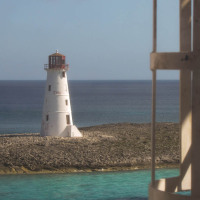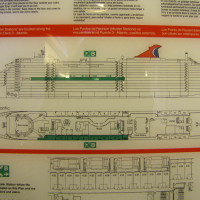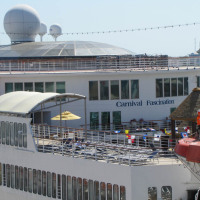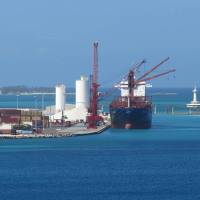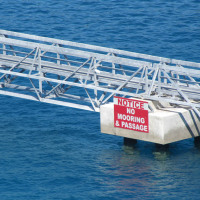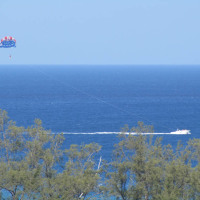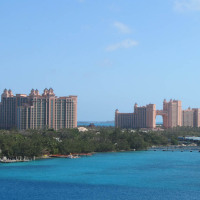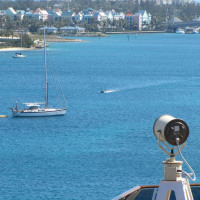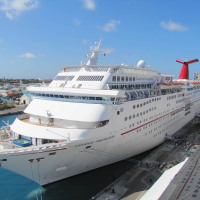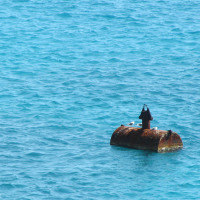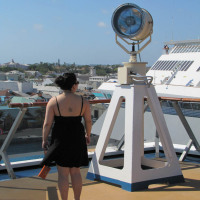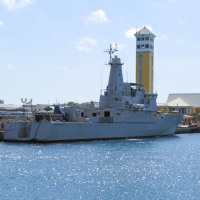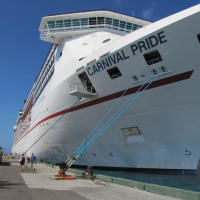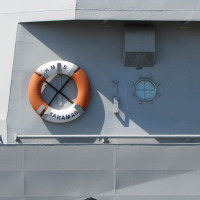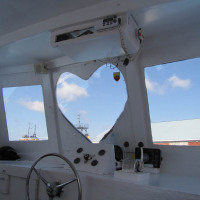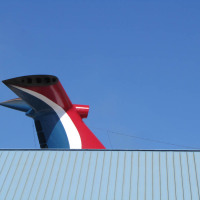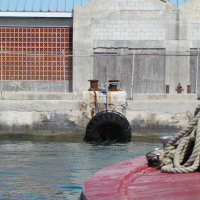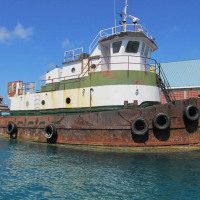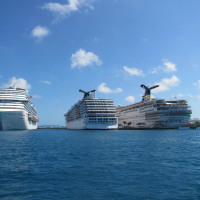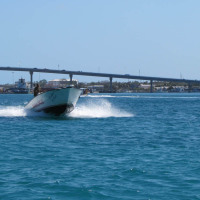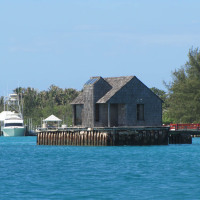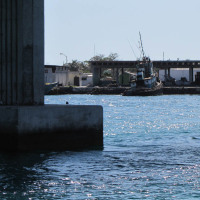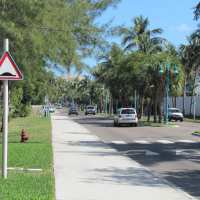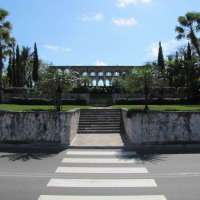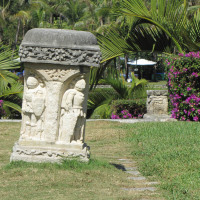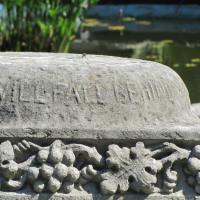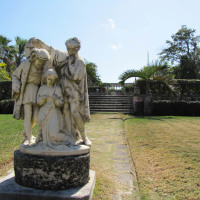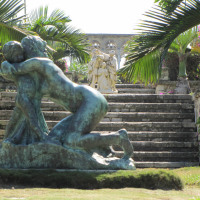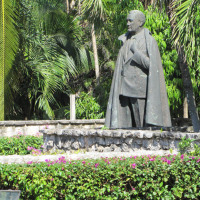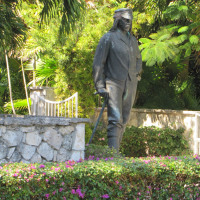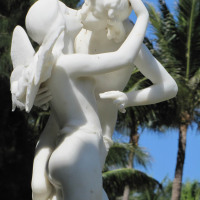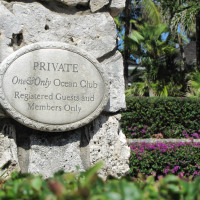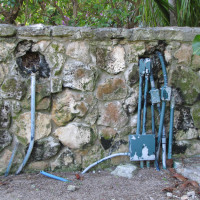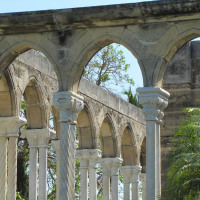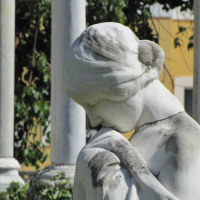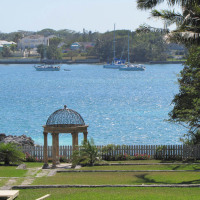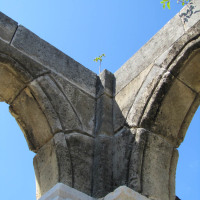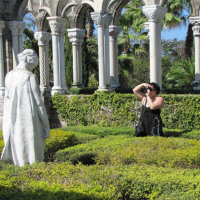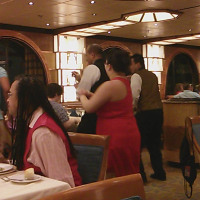Arrival in Nassau was scheduled for after 11:00 a.m., so we slept in a bit and had a nice breakfast in our cabin. We happened to turn on the television to CNN and watched an update on the Carnival Triumph, the cruise ship that was stranded in the Gulf of Mexico after an engine fire.
The Carnival Triumph
We’d been keeping an eye on the situation on the Carnival Triumph all week. On Thursday morning, it was approaching Mobile, Alabama, so it could finally dock and disembark its passengers (which it did very late that evening). Melissa and I love cruising, and it is a very safe, enjoyable, and affordable way to travel, but there have been a couple of incidents that give us pause.
You might be thinking of the Costa Concordia, which ran aground in the Mediterranean and killed a number of passengers. That was caused by an incompetent captain (who was showboating when he ran the ship aground, and then notoriously evacuated himself before evacuating his passengers and crew—a serious violation of maritime law and tradition). But I’m not too concerned about that. There does not seem to be a pattern of incompetence among cruise ship captains, so I have no reason to believe the Concordia disaster wasn’t an isolated incident.
Our concern is about something that has now established itself as a pattern—engine fires that result in a complete loss of ship’s power, food shortages, overflowing sewage systems, and more.
Back in 2009, Melissa and I went on a Bradford Family Reunion cruise on the Carnival Splendor, which was then a very new ship. Months later, as the Splendor was sailing in the Pacific Ocean off the coasts of Mexico and California, the ship experienced an engine fire. Subsequently the ship lost power and was set adrift. Food ran out quickly, and rations had to be delivered by the U.S. Navy. Passengers reported overflowing toilets and other serious problems.
Carnival promised at the time to look into why the fire resulted in such a catastrophic, across-the-board electrical failure, which should not have happened, and they assured us that they would make sure it never happened again. We took them at their word. And then, almost four years later, the Carnival Triumph suffered an engine fire that resulted in an eerily similar across-the-board electrical failure, food shortages, and overflowing sewage systems. Obviously Carnival learned nothing about redundancy from the Splendor incident.
Look, accidents happen. The fact is that there will be occasional engine fires, mechanical failures, and other problems on cruise ships. The cruise operators should do everything they can to minimize these incidents, but they also need to be prepared to deal with them. An engine room fire is going to shut down the engine . . . and since the engine powers the electrical system, it will have follow-on impacts. But why can’t cruise ships have a redundant power system that can power a limited sub-set of lighting, water, sewage, and food preparation systems? And most troubling of all, why aren’t there sufficient food rations on board to keep people fed through a power failure until they get to a port?
In both the Splendor and Triumph incidents, nobody died. The crew handled the situations the best that they could, given the situations, and both ships received help from other vessels (the USS Ronald Reagan in the Splendor’s case, and another cruise ship in the Triumph’s case). But these are situations that should never occur on a modern cruise ship, especially not on two of the newest ships in the Carnival fleet. A complete electrical failure is inexcusable. A complete sewage system failure is inexcusable. A food shortage is inexcusable.
Carnival has a lot of explaining to do . . . especially since, after the Splendor incident, they promised this would never happen again.
Nassau, Bahamas
When we arrived in Nassau, we took a bunch of photos from the ship and then disembarked. Melissa had plans to go visit the Versailles Gardens and the Cloisters, which are located across Nassau Harbor on Paradise Island (which was known as Hog Island until the marketers got a hold of it in the 1960’s). There are a few ways to get across, and we decided on the ferry. It was four dollars each way—sixteen total for the two of us.
The Bahamas dollar is artificially pegged to the U.S. dollar, so American money is generally accepted on the islands (the same as it was in Bermuda).
The ferry took about fifteen minutes. Pretty much everybody else heading to Paradise Island was going there to gamble at the Atlantis Hotel and Resort. We don’t understand why somebody would leave a ship—which has a casino on it—to go gamble in a casino in port. Go figure. The Versailles Gardens and the Cloister were both located about a twenty-five minute walk from the ferry terminal.
I was impressed with how nice and helpful so many of the locals were. Several times people would call out from cars to tell us which way it was to the resort, or to the beach. Apparently most tourists don’t have the same taste in destinations as Melissa and I do. We politely told them all that we appreciated their help, but we were heading to the Cloisters.
The Cloisters are the remains of the cloisters (i.e., the place where nuns or monks live) at a fourteenth century Augustinian monastery that was located in Montrejeau, France. They were transported to the island by the eccentric William Randolph Hearst in the 1920’s and then assembled in the 1960’s. They are maintained by a neighboring resort, which owns the property and has turned it and the surrounding land into a lovely garden with statues and columns and such. We took a lot of great photos.
Melissa originally had some grander plans to see some other sights back in Nassau, but after grabbing a bite to eat at a local grill (including our first taste of conch) and heading back to the ferry, we were pretty sweaty and tired and ready to go back to our cabin. We also had our nice dinner at 6:00 p.m., so we wanted to be back on board before 5:00 p.m. so we had some time to clean up and get ready. We try not to miss the nice dinner, especially since they have been extremely accommodating of Melissa’s new-found food allergies.
After dinner Melissa got a nice necklace as her Valentine’s present . . . even though it wasn’t actually Saint Valentine’s Day. The church removed him from the official Roman calendar some time ago because we aren’t sure whether or not he really existed. February 14th is now recognized as the feast day of Saints Cyril and Methodius, in celebration of the men who brought Christianity to the Slavic peoples. Saint Cyril developed the Cyrillic script that is still used in many places today.

